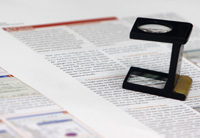 “Workarounds,” a word borrowed from the techie community, has become an interesting part of our business vocabulary, generally meaning if the way you usually do it, or are supposed to do it, doesn’t work, or if you’re not sure how to do it, here’s how to work around it to get the job done.
“Workarounds,” a word borrowed from the techie community, has become an interesting part of our business vocabulary, generally meaning if the way you usually do it, or are supposed to do it, doesn’t work, or if you’re not sure how to do it, here’s how to work around it to get the job done.
Many of us were taught – or at least thought we were taught – that there is only one correct way to write. Certainly when you are talking about a prescribed type of writing, say a thesis or a dissertation, that is true.
But in business writing, workarounds can get that piece of writing done both quickly and correctly, and can be useful when we’re not certain of the grammatical correctness of what we have written. There are many correct ways to get the job done, and in the typical business situation we do not have time to spend figuring out how to fix a particular phrase or sentence exactly as written. Business writing is not, and should not, be an English class exercise. Business writing is a tool – a way to get the job done. And the writing itself should be correctly done to enhance your professionalism and credibility.
So let’s talk about a couple of quick, correct workarounds.
1a. Here’s a very common grammatical error. So common, you may not see it at first:
Each employee will have a chance to show their best practices at the conference.
The grammatical error in this sentence is that you are talking about each employee. One at a time. Singular. Each employee’s individual best practice (or practices) is not their best practice, but his or her best practice or, if more than one, practices. If you were fixing that sentence as written, to be correct, you would say:
Each employee will have a chance to show his or her best practice (or practices, if each is allowed to show more than one) at the conference.
If you know that all of the employees we are talking about are female, you could just use “her best practices….” If all of the employees we are talking about are male, then use “his best practices….”
But if the employees are a mixed group – some male, some female – or if you don’t know the composition of the group by gender, use his or her.
That’s the grammatically correct way to fix that specific sentence, keeping it generally as is.
Here’s one workaround that could avoid the seeming awkwardness of his or her:
Each employee will have a chance to show an original best practice at the conference.
If some of the employees will show more than one original best practice, the sentence could be:
Each employee will have a chance to show original best practices at the conference.
1b. The problem in the original sentence is that each employee (singular) does not match up with their (plural). Another way to make the original sentence grammatically correct would be:
Employees will have a chance to show their best practices at the conference.
In this corrected version, Employees (plural) matches up with their (also plural).
2. Often, and this also happens frequently when you are editing someone else’s writing, as well as with your own writing, the sentence is such a mish-mash of stuff that fixing it as written is overwhelming.
Work around it. Get to the “bare bones” of what you (or the writer, if you are editing) are trying to say. Then re-write, to make it both grammatically correct, and understandable.
So – to be sure you are writing correctly and clearly when you are not sure:
Step 1: Recognize and identify the error, errors, or cause of confusion.
Step 2: Make your correction, using a good grammar guide or a good “workaround.”
We invite you to subscribe to our blog, and to our newsletter.
Gail Tycer offers business writing workshops and presentations, executive coaching,consulting, and writing services. To discuss how we can help, call Gail at 503/292-9681, or email gail@gailtycer.com




 [
[